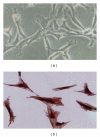AVE0991, a Nonpeptide Compound, Attenuates Angiotensin II-Induced Vascular Smooth Muscle Cell Proliferation via Induction of Heme Oxygenase-1 and Downregulation of p-38 MAPK Phosphorylation
- PMID: 22518299
- PMCID: PMC3299313
- DOI: 10.1155/2012/958298
AVE0991, a Nonpeptide Compound, Attenuates Angiotensin II-Induced Vascular Smooth Muscle Cell Proliferation via Induction of Heme Oxygenase-1 and Downregulation of p-38 MAPK Phosphorylation
Abstract
The nonpeptide AVE0991 is an agonist of the angiotensin-(1-7) (Ang-(1-7)) Mas receptor and is expected to be a putative new drug for treatment of cardiovascular disease. However, the mechanisms involved in the antiproliferative effects of AVE0991 are not fully understood. We saw that the compound attenuated proliferation in an angiotensin II-induced rat vascular smooth muscle cells (VSMC) proliferation model. Moreover, treatment with AVE0991 (10(-5) mol/L or 10(-7) mol/L) significantly attenuated reactive oxygen species (ROS) production, phosphorylation of p38 MAPK, and dose-dependently (10(-8) to 10(-5) mol/L) inhibited Ang II-induced VSMC proliferation. Meanwhile, heme oxygenase-1 (HO-1) expression increased in the AVE0991 + Ang II group (10(-5) mol/L or 10(-6) mol/L). However, the beneficial effects of AVE0991 were completely abolished when the VSMC were pretreated with A-779 (10(-6) mol/L). Furthermore, treatment with the HO-1 inhibitor ZnPPIX attenuated the inhibitory effect of AVE0991 on Ang II-induced p38MAPK phosphorylation. These results suggest that AVE0991 attenuates Ang II-induced VSMC proliferation in a dose-dependent fashion and that this effect is associated with the Mas/HO-1/p38 MAPK signaling pathway.
Figures









References
-
- Santos RAS, Campagnole-Santos MJ, Andrade SP. Angiotensin-(1-7): an update. Regulatory Peptides. 2000;91(1–3):45–62. - PubMed
-
- Grobe JL, Mecca AP, Lingis M, et al. Prevention of angiotensin II-induced cardiac remodeling by angiotensin-(1-7) American Journal of Physiology. 2007;292(2):H736–H742. - PubMed
-
- Tallant EA, Clark MA. Molecular mechanisms of inhibition of vascular growth by angiotensin-(1-7) Hypertension. 2003;42(4):574–579. - PubMed
-
- Silva ACSE, Bello APC, Baracho NCV, Khosla MC, Santos RAS. Diuresis and natriuresis produced by long term administration of a selective angiotensin-(1-7) antagonist in normotensive and hypertensive rats. Regulatory Peptides. 1998;74(2-3):177–184. - PubMed
LinkOut - more resources
Full Text Sources
Miscellaneous

